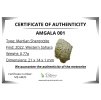Meteorite Amgala 001 – Western Sahara
Type: Martian meteorite / Shergottite
Locality: Western Sahara
Weight: 0,77g
Dimensions: 21 x 14 x 1 mm
Year found: 2022
Total known weight: 34,67 kg
Surface treatment: cut, polished slice
Packaging: Transparent plastic box (8,4 x 5,8 x 2,4 cm)
| Category: | Amgala 001 |
|---|---|
| By name: | Amgala 001 |
| ? Type: | Stony |
| Subspecies: | Achondrite |
| ? Surface treatment: | Cut |
| Packaging: | In box |
| ? Origin: | Mars |
Amgala 001 Meteorite – Martian Shergottite from Saguia el Hamra Region
Amgala 001 is a meteorite discovered in December 2022 in the Saguia el Hamra region, Western Sahara, near Meharrize. The total mass of the recovered fragments is approximately 35 kilograms, with the largest single piece weighing 5.2 kilograms.
Origin
The Amgala 001 meteorite arrived on Earth following a powerful impact that ejected rock from the surface of Mars into space. This process begins when an asteroid or comet strikes Mars with enough energy to cause a massive explosion. The impact creates a crater and releases energy that blasts surface rocks into space.
These ejected fragments escape Mars' gravity and travel through space as meteoroids. If their trajectory intersects Earth's orbit, they may be pulled in by gravity and enter the atmosphere as meteors. If they survive the entry, they become meteorites.
Characteristics
Amgala 001 has a weathered brown surface with a knobby texture, while the interior is greenish-gray with darker olivine phenocrysts. It is marked by a high degree of shock metamorphism and low degree of weathering. Its chemical and isotopic composition of trapped gases is very similar to the Martian atmosphere, confirmed by Viking mission measurements on Mars.
Classification
This meteorite is classified as a Shergottite, a type of Martian meteorite. About three-quarters of all known Martian meteorites are shergottites. The name comes from the Shergotty meteorite that fell in India in 1865. Shergottites are igneous rocks with mafic to ultramafic lithology.
- Mafic rocks are rich in magnesium and iron and contain dark minerals like pyroxenes, olivine, and amphiboles. Their dark color is due to the high iron and magnesium content. Common examples include basalts and gabbros.
- Ultramafic rocks contain even more magnesium and iron and very little silica. These are extremely dark to black rocks with high content of olivine and pyroxene. Examples include peridotites and dunites.
Both rock types usually form in Earth’s mantle and lower crust. Studying them gives important insight into the composition and processes of planetary interiors, including those of Mars.
Age
Shergottites crystallized about 180 million years ago. This relatively young age is surprising given that most of Mars' surface appears much older. It's also unexpected due to Mars' smaller size, which suggests quicker cooling and older crust.
This discrepancy between expected and measured ages is known as the "shergottite age paradox". Some scientists believe these meteorites may be much older than current dating methods can detect. This paradox remains an active topic of scientific research.







